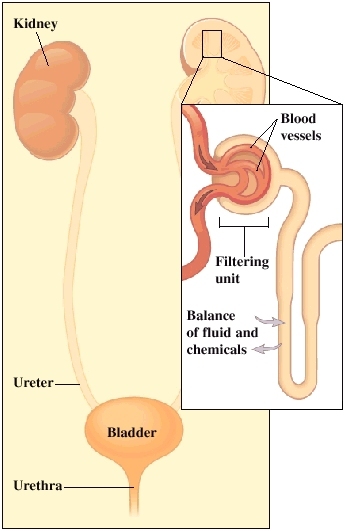Kidney (Renal) Cancer: Introduction
What is cancer?
Cancer is when cells in the body change and grow out of control. To help you understand what happens when you have cancer, let’s look at how your body works normally. Your body is made up of tiny building blocks called cells. Normal cells grow when your body needs them, and die when your body does not need them any longer.
Cancer is made up of abnormal cells that grow even though your body doesn’t need them. In most cancers, the abnormal cells grow to form a lump or mass called a tumor. If cancer cells are in the body long enough, they can grow into (invade) nearby areas. They can even spread to other parts of the body (metastasis).
What is kidney cancer?
Cancer that starts in kidney cells is called kidney or renal cancer.
Understanding the kidneys
The kidneys are 2 bean-shaped organs. Each is about the size of a bar of soap. They sit in the body towards the middle to lower part of the back. There is 1 kidney on each side of the spine. The kidneys help filter waste and excess fluid from the blood. The liquid and waste is then sent as urine to the bladder through thin tubes called ureters. Urine then leaves the body through a tube called the urethra. The kidneys also help control blood pressure. And they help make sure there are enough red blood cells in the body.
When kidney cancer forms
A kidney is made up of many layers of cells. Kidney cancer can affect any one or all of these layers. The cancer can stop the kidneys from working normally. Kidney cancer may spread to other parts of the body. When cancer spreads, it’s called metastasis. The more cancer spreads (metastasizes), the harder it is to treat.
What are the different types of kidney cancer?
The main type of kidney cancer is called renal cell carcinoma (RCC). About 9 out of 10 kidney cancer tumors are this type. If you have this type of kidney cancer, you may have more than one tumor in one or both kidneys. These may be large by the time they are diagnosed. But most cases of kidney cancer are found before the cancer has spread to other organs.
There are different types of RCC. A healthcare provider called a pathologist identifies these types by looking at the cancer cells under a microscope. The types of RCC include:
Clear cell. This is the most common type of RCC. The cancer cells look pale or clear.
Papillary. This is the second most common type of RCC. This type of tumor has tiny fingerlike growths.
Chromophobe. This is a rare form of RCC. The cells are larger than other types of RCC.
Collecting duct. This is also a rare form of RCC. The cancer cells look like irregular tubes.
Unclassified. This includes tumors that have cells from more than 1 type of cancer. It also includes tumors with cells that don’t fit into the other categories.
Other types of kidney cancer
Other less-common types of kidney cancers include:
Transitional cell carcinoma. This is also known as urothelial carcinoma. It starts where the ureter and kidney meet. This area is called the renal pelvis. This type of kidney cancer can act and look like bladder cancer.
Wilms’ tumor. This cancer most always occurs in children. It's very rare in adults.
Renal sarcoma. This is a very rare type of kidney cancer. It begins in the blood vessels and connective tissue around the kidneys.
Kidney tumors that aren’t cancer
There are several types of kidney tumors that are not cancer (benign). These include renal cell adenoma, renal oncocytoma, and angiomyolipoma. These types of tumors may still affect kidney function and can cause pain and other symptoms. But the cells usually do not spread to other organs.
Talk with your healthcare provider
If you have questions about kidney cancer, talk with your healthcare provider. Your healthcare provider can help you understand more about this cancer.
How is kidney cancer treated?
Specific treatment for kidney cancer will be determined by your doctor, based on the following factors:
Your age, overall health and medical history
Extent of the disease
Your tolerance for specific medications, procedures or therapies
Expectations for the course of the disease
Your opinion or preference
Treatment may include the following approaches:
Surgery: Surgery to remove the kidney is called a nephrectomy. This is the most common treatment for kidney cancer. Different types of nephrectomy procedures include:
Radical nephrectomy: The whole kidney is removed, along with the adrenal gland and tissue around the kidney. Sometimes lymph nodes in the area are also removed.
Simple nephrectomy. Only the kidney is removed.
Partial nephrectomy. Only the part of the kidney that contains the tumor is removed.
The remaining kidney is generally able to perform the work of both kidneys.
Radiation therapy: Radiation therapy uses high-energy X-rays to kill cancer cells. It is sometimes used to relieve pain when kidney cancer has spread to the bone.
Targeted therapy: Targeted therapy uses drugs that attack specific parts of cancer cells. These drugs work differently from standard chemotherapy drugs and often have less severe side effects. They are commonly the first line of treatment for advanced kidney cancer. Examples include sunitinib, sorafenib, temsirolimus, everolimus, bevacizumab and pazopanib).
Biological therapy (also called immunotherapy): Biological therapy is a treatment that uses the body's own immune system to fight cancer.
Chemotherapy: Chemotherapy is the use of drugs to kill cancer cells. Unfortunately, kidney cancer is often resistant to chemotherapy drugs.
Arterial embolization: Arterial embolization is a procedure in which small pieces of a special gelatin sponge, or other material, are injected through a catheter to clog the main renal blood vessel. This procedure shrinks the tumor by depriving it of the oxygen-carrying blood and other substances it needs to grow. It may also be used before an operation to make surgery easier or to provide relief from pain when removal of the tumor is not possible.






